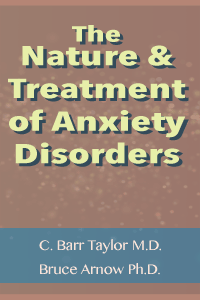
The Nature and Treatment of Anxiety Disorders
Publisher: Free Press
Please provide your name and email to get free downloads.
Downloaded 27494 times since
At one time or another, everyone experience some form of anxiety, in the United States alone, doctors write over 80 million prescriptions for anti-anxiety drugs each year. While our understanding of the various anxiety disorders has increased substantially, practitioners remain faced with a confusing array of seemingly contradictory treatment approaches. Now, C. Barr Taylor and Bruce A. Arnow integrate this wide range of theoretical, empirical, and clinical knowledge into a coherent framework for understanding and treating anxiety disorders.
Written by a psychiatrist and a psychologist, this volume brings together the psychological and biological approaches to the study of anxiety. Throughout, the author adopt a consistent “symptom focused” treatment approach which calls upon those specific psychopharmacologic, behavioral, and psychotherapeutic techniques which they and other researchers have identified as most effective in treating each disorder. The purpose of such treatment is, at minimum, to reduce the intensity and frequency of the presenting symptoms, in some cases, such problems will resolve entirely. Depending upon the type of anxiety disorder, Taylor and Arnow’s approach often begins with psychopharmacology combined with cognitive behavioral therapy and other directive therapies. Later, after the presenting complaint has been addressed, treatment may evolve to include family, marital, or psychodynamic therapy as appropriate.
The authors argue that anxiety is best understood and treated from a biopsychological perspective which assumes that various biological, psychological, and social factors interact to produce a patient’s unique manifestations of anxiety. The biological factors include the patient’s genetic endowment, drug and medication use, illnesses, and vulnerability to stress and separation. The psychological factors include the patient’s learning history and experience and a variety of cognitive factors, including perception and appraisal patterns. The social factors include family, work, and recreational and cultural environment. Each of these factors plays a role in the final expression of symptoms in any patient.
After a discussion of theories of anxiety and current diagnostic issues, Taylor and Arnow provide an overview of their approach to treatment. They then systemically and thoroughly address the practical questions of how to assess and treat both acute and generalized anxiety disorder, panic disorder, agoraphobia, and social and simple phobias. Detailed case examples illustrate the course and treatment of each disorder.
Offering a view of pharmacology, including specific guidelines for the administration of medications, a clinical flowchart for use in diagnosis, and three special appendixes containing assessment instruments and an exposure treatment protocol, this invaluable book promises to be the reference on anxiety disorders for medical and mental health professionals, students, and researchers.
Reviews:
“Taylor and Arnow have produced a ‘state-of-the-art’ book on the anxiety disorders. . . . The outstanding strength. . . lies in its detailed explication of assessment and treatment techniques. . . an integration of pharmacological and psychological techniques has never been explained or described more clearly. . . . Every clinician will want to read this book to make sure that both drug and psychological treatments are prescribed appropriately and interacting appropriately.”
–David H. Barlow Ph.D.
“It is refreshing to read this easy-to-follow text for clinicians that is welcome for its interdisciplinary orientation and the helpful guidance it offers practitioners.”
–Isaac M. Marks M.D.
“This well-written book provides comprehensive coverage of the phenomenology of the anxiety disorders, the various theories regarding etiology and the latest in treatment approaches, from behavior therapy to psychopharmacology. It should prove useful to all mental health professionals who work with anxiety disorders and to their students, for whom it provides an excellent knowledge base.”
–Stewart Agras M.D.
Our staff has been up all night selecting the best new e-books to share. Will you send us a few bucks to keep the coffee flowing?


One comment on “The Nature and Treatment of Anxiety Disorders”
Pakistan:
a huge amount of knowledge explore in it